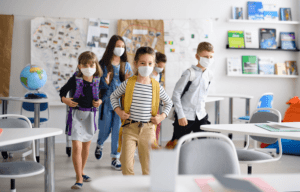6/10/21—As COVID-19 has impacted many areas of life, one seemingly positive note is in the historically low levels of influenza experienced during the latest flu season. “Nobody has seen a flu season this low, ever. And some of us have some gray hair,” says William Schaffner, MD, an infectious disease expert at Vanderbilt University. With less than 2,000 lab-confirmed cases, the United States only saw a fraction of the typical 200,000 lab-confirmed cases usually noted by the CDC. Experts suggest that precautions taken to avoid COVID-19, such as masking, social distancing, and hand hygiene may have helped to keep the flu at bay.
In addition to the prevention protection, Shaffer thinks a big factor in mitigating flu this past season was the lack of spread by children, as many schools remained closed. Jennifer Nayak, MD, a pediatric infectious disease specialist at the University of Rochester Medical School says kids shed flu virus for longer periods of time than adults do, and begin to shed it a day or two before they have notable symptoms. “As we’ve learned the hard way, with COVID, shedding virus before you are symptomatic makes it really, really hard to contain an infection,” she says.
As more schools and offices reopen in the fall, scientists will be monitoring the situation, wary of the lowered immunity caused by the minimal infections of last season. “Every year, anywhere between 20 to 30 percent of the population gets its immunity sort of boosted and stimulated by being exposed to the flu virus,” said Dr. Richard Webby, a virologist at the St. Jude Children’s Research Hospital in Memphis. “We are not going to have that this year.”
With fewer cases and fewer strains circulated, scientists have also had a more difficult time predicting which strains should be included in vaccine production. While less infections can mean less mutations, effectiveness of the flu vaccine could also be hampered with so few positive samples collected in the over one million taken last season. Experts maintain vaccination is still key to flu prevention, and will provide some protection regardless. Dr. Jesse Goodman, professor of medicine and infectious disease at Georgetown University said prevention measures like diligent hand hygiene and social distancing are things the public can carry with them into the fall. “If some of these practices continue, it could be that things aren’t bad next year,” he said. “One question will be, how much will those habits persist?”
According to a 2018 estimate from Challenger, Gray & Christmas Inc., the flu cost U.S. employers alone over $21 billion in lost productivity. As businesses attempt to recoup COVID-related losses and plan to reopen responsibly, maintaining health and safety is imperative. The ability to stop spread of infectious disease in your facility can mean the difference between one individual out with the flu and an entire department unable to work. Originally developed to combat COVID-19, AlertTrace can mitigate spread of any infectious disease. In the event that an employee tests positive, administrators are able to identify an employee’s historical anonymized contacts to safeguard the workforce in a matter of minutes. And with the new, client requested, and optional Indoor Location Tracing feature, data-driven decisions on sanitization can be made after a confirmed infection. Contact us today to learn how AlertTrace can help reduce illness, as well as limit the financial impact and productivity loss that many employers face each year.




